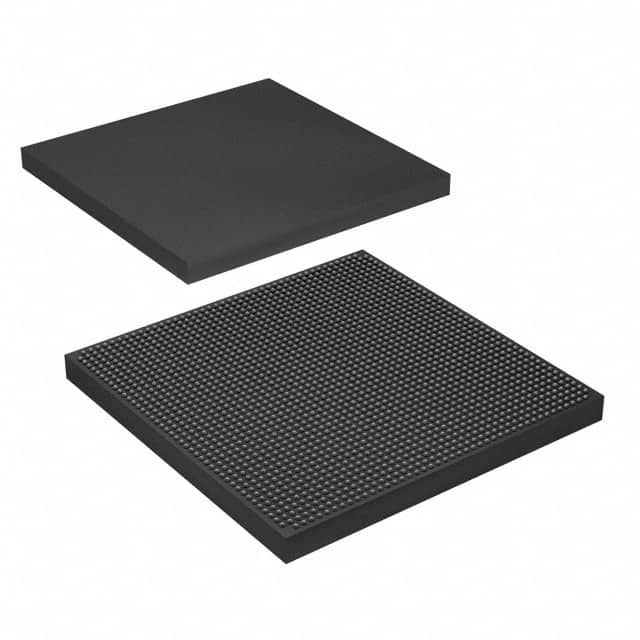EP4SGX530NF45C3
Product Overview
- Category: Integrated Circuit (IC)
- Use: Programmable Logic Device (PLD)
- Characteristics: High-performance, low-power consumption
- Package: 45nm FineLine BGA (Ball Grid Array)
- Essence: Field-Programmable Gate Array (FPGA)
- Packaging/Quantity: Tray packaging, quantity varies
Specifications
- Manufacturer: Intel Corporation
- Family: Stratix IV GX
- Device: EP4SGX530NF45C3
- Technology: 45nm
- Logic Elements: 531,200
- Embedded Multipliers: 1,288
- Maximum User I/Os: 1,040
- Memory Blocks: 13,824 Kbits
- Operating Voltage: 1.2V
- Speed Grade: -3
Detailed Pin Configuration
The EP4SGX530NF45C3 has a complex pin configuration with various pins serving different functions. The detailed pin configuration can be found in the manufacturer's datasheet.
Functional Features
- High-performance FPGA suitable for demanding applications
- Low-power consumption for energy-efficient designs
- Large number of logic elements and memory blocks for complex designs
- Embedded multipliers for efficient digital signal processing
- Wide range of I/O options for versatile connectivity
- Support for various communication protocols and interfaces
Advantages and Disadvantages
Advantages: - High performance and flexibility due to programmability - Lower development time compared to custom ASIC designs - Ability to reconfigure the device for different applications - Cost-effective solution for prototyping and low-volume production
Disadvantages: - Higher power consumption compared to dedicated hardware solutions - Limited resources may restrict the complexity of designs - Longer design iterations due to programming and verification processes
Working Principles
The EP4SGX530NF45C3 is based on FPGA technology, which allows users to configure the device according to their specific requirements. The device consists of a large number of configurable logic elements and memory blocks interconnected through programmable routing resources. These resources can be programmed using hardware description languages (HDL) or graphical design tools.
During operation, the user's design is loaded into the FPGA, and the configuration data is stored in internal memory cells. The logic elements and interconnections are then dynamically configured to implement the desired functionality. This flexibility enables rapid prototyping, design iteration, and reconfiguration for different applications.
Detailed Application Field Plans
The EP4SGX530NF45C3 finds applications in various fields, including:
- Communications: Used in high-speed data transmission systems, network routers, and switches.
- Aerospace and Defense: Employed in radar systems, avionics, and military communication equipment.
- Industrial Automation: Utilized in control systems, robotics, and factory automation.
- Medical Devices: Integrated into medical imaging systems, patient monitoring devices, and diagnostic equipment.
- Automotive: Applied in advanced driver-assistance systems (ADAS), infotainment systems, and engine control units (ECU).
Detailed and Complete Alternative Models
- EP4SGX230KF40C2: A lower-density variant with 230,400 logic elements and 576 embedded multipliers.
- EP4SGX530KH40C2: A higher-speed grade variant with the same logic capacity but improved performance.
- EP4SGX110DF29C2: A cost-effective option with reduced logic elements but suitable for less complex designs.
These alternative models offer different trade-offs in terms of logic capacity, performance, and cost, allowing designers to choose the most appropriate FPGA for their specific application needs.
Word count: 455 words
Senaraikan 10 soalan dan jawapan biasa yang berkaitan dengan aplikasi EP4SGX530NF45C3 dalam penyelesaian teknikal
Sure! Here are 10 common questions and answers related to the application of EP4SGX530NF45C3 in technical solutions:
Q: What is EP4SGX530NF45C3? A: EP4SGX530NF45C3 is a specific model of Field-Programmable Gate Array (FPGA) manufactured by Intel.
Q: What are the key features of EP4SGX530NF45C3? A: Some key features of EP4SGX530NF45C3 include high-speed transceivers, large logic capacity, embedded memory blocks, and support for various I/O standards.
Q: In what technical solutions can EP4SGX530NF45C3 be used? A: EP4SGX530NF45C3 can be used in a wide range of applications such as telecommunications, networking, industrial automation, video processing, and high-performance computing.
Q: How does EP4SGX530NF45C3 differ from other FPGA models? A: EP4SGX530NF45C3 offers a specific combination of logic capacity, transceiver capabilities, and I/O standards that make it suitable for certain applications. It's important to compare specifications to determine the best fit for your project.
Q: Can EP4SGX530NF45C3 be programmed using industry-standard design tools? A: Yes, EP4SGX530NF45C3 can be programmed using popular design tools like Quartus Prime, which is provided by Intel.
Q: What is the power consumption of EP4SGX530NF45C3? A: The power consumption of EP4SGX530NF45C3 depends on the specific configuration and usage scenario. It's recommended to refer to the datasheet or consult Intel's documentation for detailed power consumption information.
Q: Does EP4SGX530NF45C3 support high-speed serial communication? A: Yes, EP4SGX530NF45C3 is equipped with high-speed transceivers that support various protocols like PCIe, Ethernet, and USB.
Q: Can EP4SGX530NF45C3 be used in safety-critical applications? A: EP4SGX530NF45C3 can be used in safety-critical applications, but additional measures such as redundancy and fault-tolerant design may be required to meet specific safety standards.
Q: Are there any development boards available for EP4SGX530NF45C3? A: Yes, Intel provides development boards specifically designed for EP4SGX530NF45C3, which can help in prototyping and testing your technical solutions.
Q: Where can I find technical support or documentation for EP4SGX530NF45C3? A: You can find technical support, documentation, and resources for EP4SGX530NF45C3 on Intel's official website or by contacting their customer support team.


